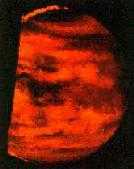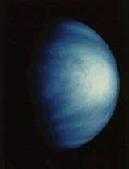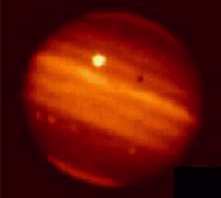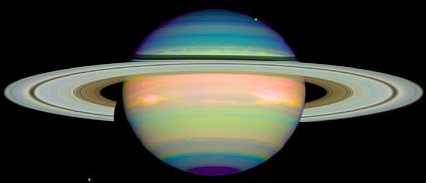



|
|
 THE PLANETS AND OUR SOLAR SYSTEM
THE PLANETS AND OUR SOLAR SYSTEM
All of the planets and moons in our solar system emit strongly in the infrared. This infrared emission is the heat from atmospheres and surfaces which peaks in the mid to far infrared (15 to 100 microns). Solar system objects also reflect infrared radiation from the Sun. This reflected radiation peaks in the near infrared at about 0.5 microns. The study of the infrared radiation from solar system objects has given us much information about their composition. For planets and moons which have atmospheres, infrared studies can show us how the abundance and composition of atmospheric gases as well as the temperature of the atmosphere vary with depth. In addition, infrared astronomy has led to the discovery of new comets and asteroids and bands of dust which lie in our solar system.
| VENUS: Sunlight passing through the atmosphere of Venus is absorbed by its surface which causes it to heat up, giving off radiation which is primarily infrared. The carbon dioxide in Venus's thick atmosphere traps much of the infrared heat, giving Venus a surface temperature of 750K (890 degrees Fahrenheit) which is hot enough to melt lead. By studying the infrared spectra of Venus, astronomers found that sulfuric acid droplets exist in its atmosphere. Compare the infrared image of the clouds of Venus on the left with the visible light image of Venus on the right. Both images were taken by the Galileo satellite. |


|

Phil Nicholson (Cornell), Mike Meyer (UMASS) Guy Worthey (St. Ambrose University) |
JUPITER: Jupiter radiates ~1.6 times as much heat, in the form of infrared energy, as it receives from the Sun. This indicates that Jupiter has an internal source of energy - probably heat created by Jupiter's collapse when it was formed. By studying the infrared emission from Jupiter we have learned much about its cloud structure. Jupiter's belts (its dark horizontal bands) are brighter in the infrared than its zones (its bright horizontal bands) This indicates that the belts are regions of hotter gas. The temperature of Jupiter also increases towards its center, so the zones are at higher levels in Jupiter's atmosphere than the bands. To the left is an infrared image of Jupiter and one of its moons, Io (the bright spot on the image). Io has several active volcanoes and is heated by tidal forces caused by the gravitational pull of Jupiter and the other Galilean moons. |
SATURN: Like Jupiter, Saturn also radiates about twice as much radiation in the infrared as it received from the Sun. ISO was recently used to study the concentrations of heavy and ordinary hydrogen in the atmosphere of Saturn. These measurements give information about the composition of the original cloud of gas and dust from which the sun and planets formed. The HST/NICMOS infrared image of Saturn below shows the details of its cloud structure.

TITAN: In 1944, Gerard Kuiper discovered that Titan, the largest moon of Saturn, had an atmosphere. He detected the methane in Titan's atmosphere by studying its infrared emission. In 1994, astronomers using the Wide Field Planetary Camera on the Hubble Space Telescope made the first images of the surface of Titan. These images were made in the near-infrared since infrared radiation is able to penetrate the hazy atmosphere of Titan. Titan is larger than the planet Mercury and only a bit smaller than Mars. The infrared images of Titan's surface show a bright area which is a surface feature that is about 2,500 miles across (about the size of Australia). The left image below is a set of four near infrared pictures of Titan. Compare this to the visible light image of Titan on the right taken by Voyager 2. Both images are supplied by NASA and the NSSDC.
COMETS: Comets are basically dusty snowballs which orbit the Sun. They consist of an icy nucleus surrounded by a large cloud of gas and dust (called the coma). The coma is created as the ice in the nucleus is warmed and vaporizes. Comets have 2 tails, a straight gas tail and a curved dust tail. The gas tail is created by the solar wind whose magnetic fields pull the gas away from the comet's coma. The dust in the coma is not affected by magnetic fields but is pushed out by the Sun's radiation. The dust in the tail reflects sunlight and radiates in the infrared. The infrared emission from comets can be used to get information on the nature of the dust they contain as well as on the rate at which material is being lost from the nucleus. Using IRAS, astronomers discovered that dust from comets fills the Solar System and that comets are dustier than they were thought to be. Many of the meteors which are seen as they streak through our atmosphere may be the larger pieces of this comet dust. IRAS was the first satellite to discover a comet (comet IRAS-Araki-Alcock). In all, IRAS discovered 6 new comets and collected infrared data on 25 previously known comets.
COMET IMPACT WITH JUPITER: In 1994 several fragments of comet Shoemaker-Levy 9, which had broken apart during its previous orbit in 1992, collided with the planet Jupiter. These impacts released a tremendous amount of energy into Jupiter's atmosphere. Spectacular images of comet Shoemaker-Levy's collision with Jupiter were taken in the infrared. The first image shows the impact of fragment A (Courtesy of NASA/NSSDC, Tom Herbst, Max-Planck-Institut fuer Astronomie, Heidelberg, Doug Hamilton, Max-Planck-Institut fuer Kernphysik, Heidelberg, Hermann Boehnhardt, Universitaets-Sternewarte, Muenchen, and Jose Luis Ortiz Moreno, Instituto de Astrofisica de Andalucia, Granada) The second image is an infrared color composite showing fragments A,E F,G and H impacting Jupiter (Courtesy of NASA/NSSDC).
|
|